Troubled Waters project
|
After 30 years I have just been presented with an opportunity
of returning to the Antarctic - a visit arranged by a Geoff
Renner, a friend I met on my first visit and who for many
years has been a lecturer on a wide range of cruise ships
visiting many different parts of the world. In 1977 Geoff was a scientist working for the British
Antarctic Survey (BAS) and
I was a field assistant working on a seabird programme with Peter
Prince, Dr. John Croxall and others on Bird Island, South Georgia.
This time I am going south as an artist in residence on board the cruise ship Spirit of Adventure a trip on which Geoff is a lecturer and I am effectively going as a guest. Although there have been a number of opportunities in recent years to re-visit Antarctica on one of the numerous cruise ships which ferry over 25,000 visitors a year to that remote continent, I was a little reluctant to unless driven by the imperatives of some kind of project -and to that end I've had the Birdlife / RSPB albatross campaign in mind for some while. It is a hugely exciting time! |
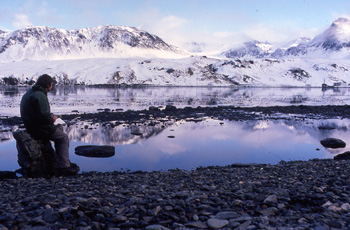 (Above) Painting at Grytvyken, South Georgia 1977. As a biological field
assistant on Bird Island (at the northern end of South Georgia) I was assigned many tasks during each 5 month stay from November to March. One day it might have been shoving an arm deep down into a wet and reeking
burrow to bring a petrel chick to the surface for ringing, or another day perhaps scrambling around a stony
beach avoiding snapping bull seals to grab fur seal pups for
tagging.
|
| The Project The albatross has featured in art, literature, science and music for many centuries. From their very first description by early sailors in the 16th century, to Samuel Taylor Coleridge's classic poem of 1798 The Rime of the Ancient Mariner in which the death of an albatross forms a central theme. From the name of an early 20th century flying machine in America, to the title for a 1968 instrumental pop music chart hit by Fleetwood Mac, the albatross has a place as a creative icon. In modern times, drawn by the enigmatic nature of their ocean wanderings and aesthetic appeal, large numbers of people on guided tours ply the seas seeking close encounters with albatrosses and other ocean wanderers. But fleets with different intent also range across southern oceans. Longline fishing fleets target vast numbers of tuna, swordfish, Patagonian toothfish and other species and their catch is in high demand; single bluefin tuna have fetched as much as US$100,000 on the Japanese market. But as well as fish over 100,000 albatrosses die each year caught on the hooks laid out on lines that can stretch across the ocean for 130 kilometres - a billion baited hooks a year set to catch fish but which also attract albatrosses. The birds get caught, dragged below the water and drown. Albatrosses are being killed in such vast numbers that they can't breed fast enough to maintain their populations putting them in real danger of extinction. Around a third of albatross deaths are caused by illegal, unreported and unregulated fishing fleets. At its worst, pirate fishing is organised crime, in which vessels plunder fish stocks with no regard for regulations, national sovereignty or bird protection. They leave devastation in their wake. The RSPB and BirdLife together created the Albatross Task Force (ATF) to seek solutions by working with fishermen on shore and at sea who are often unaware of the simple, cost-effective techniques that can rapidly reduce albatross deaths. Many of these tragic and needless deaths can be stopped by using a curtain of plastic streamers dangling from a piece of rope positioned over long lines to scare seabirds away from baited hooks. Showing fishermen how to use these techniques, and telling them about how albatross numbers are declining can achieve dramatic results. Already team members are working in South Africa and Brazil. It is these two extremes of the human relationship with ocean wanderers that is the focus of the Troubled Waters project I am developing. Firstly, on this next trip, I am keen to develop ideas and generate images that convey a feeling for the sheer beauty and energetic simplicity of the albatross and which capture the meandering spirit of their oceanic life. And secondly at a later date, to produce much more graphic interpretations of the brutal accidental collision of the birds with industrial harvesting of the oceans resources. In between is potential imagery in the science of satellite tracking, population monitoring, mortality, and feeding ecology - the subjective substance that illuminates the plight of albatrosses and other seabirds. By working in the southern seas for two or more short periods - as an 'artist in residence' on a longline fishing vessel, and as an artist 'embedded' in the Albatross Task Force - a body of work would be created which when exhibited would engage the viewer in a visceral experience offering compelling insights into our understanding of the oceans and inspire engagement and identification with the issues it highlights. A schedule of exhibitions and events at a national level and among communities involved in the issues would offer opportunities to influence decision-makers, raise awareness about specific conservation issues, and also raise funds. Educators and their young charges could engage with the project outcomes at different levels increasing the overall reach of the art and conservation project. The principal aim of the Troubled Waters project is to support the BirdLife International / RSPB Save the Albatross Campaign by building awareness, creating educational opportunities, and raising funds for the campaign. A secondary aim is to advance the idea of 'art in support of conservation' which has underpinned the range of projects undertaken by ANF over the past 18 years, many of which I have been involved in. All 12 ANF projects have worked to a very similar model, but the 'Troubled Waters' project provides many new opportunities to build on the idea and provide a substantially different model that could be used by other individual or very small groups of artists on future projects involving BirdLife International and other conservation organisations. A final aim is to encourage and enable personal creative development at a critical point in my career. After 35 years as a professional artist (painter, printmaker and sometime film-maker) the project would give the freedom to develop creative ideas and contribute to personal and professional growth. Updates about all of this will follow when the opportunities arise. To return to HOMEPAGE click here |
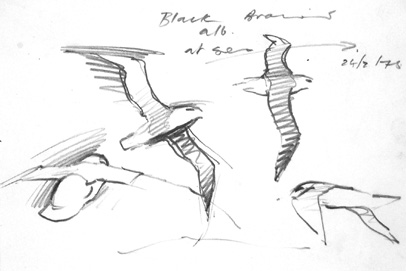 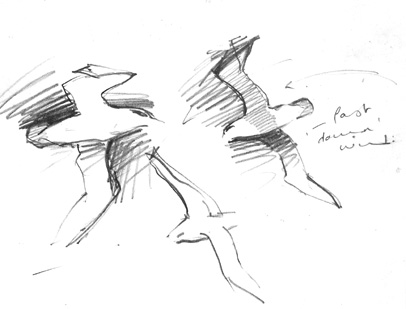 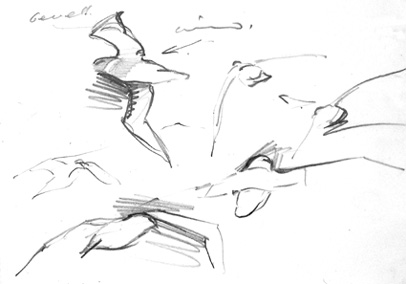 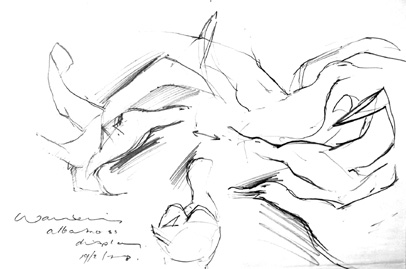  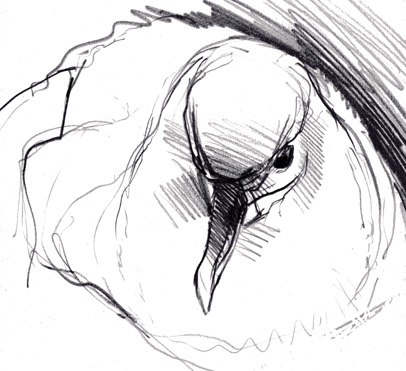
All
the drawing above are from the three trips I made during
the austral summers 1975 - 1977 on Bird Island, at sea around
South Georgia or travelling further south across Drake's Passage to the Antarctic
peninsula.
|